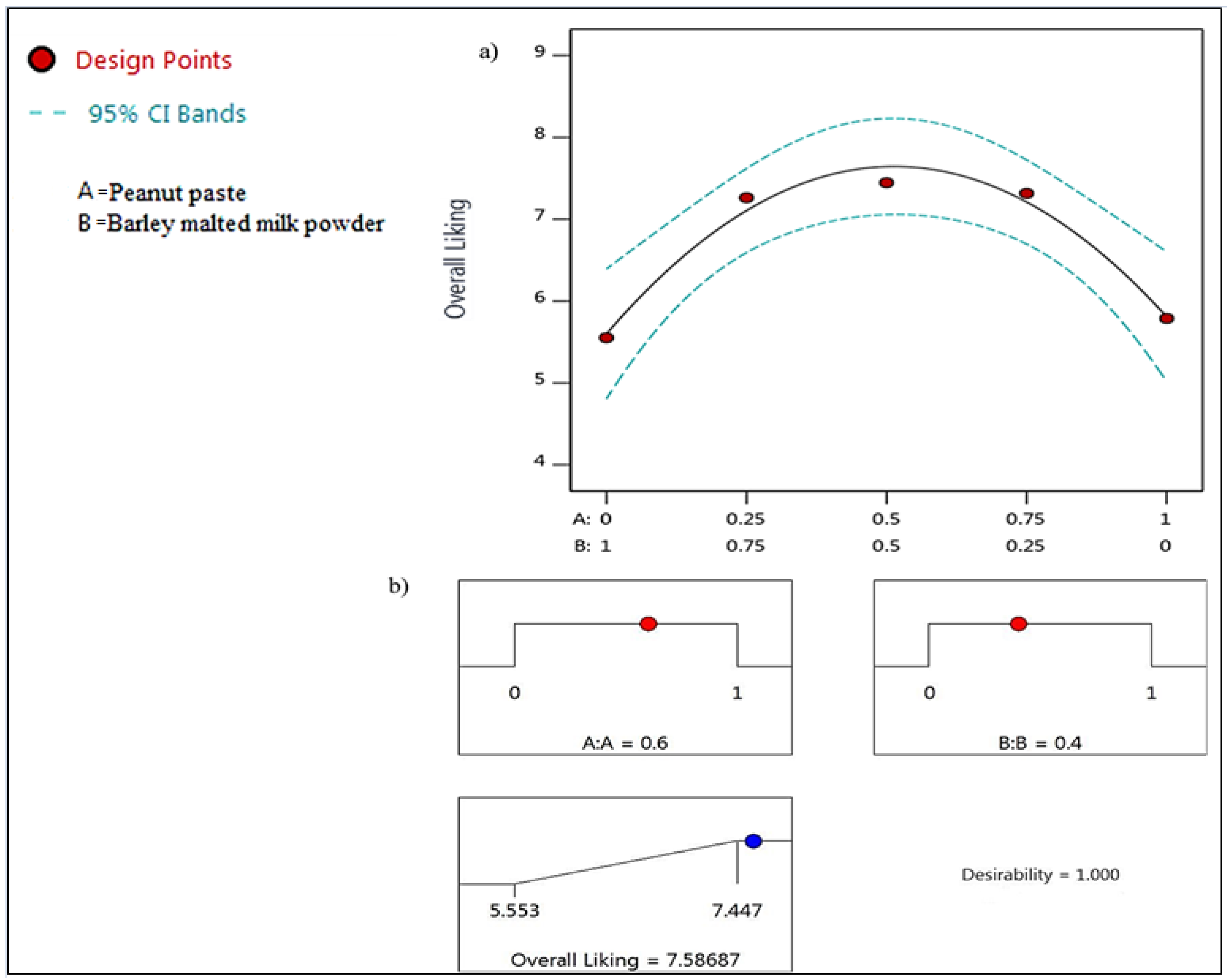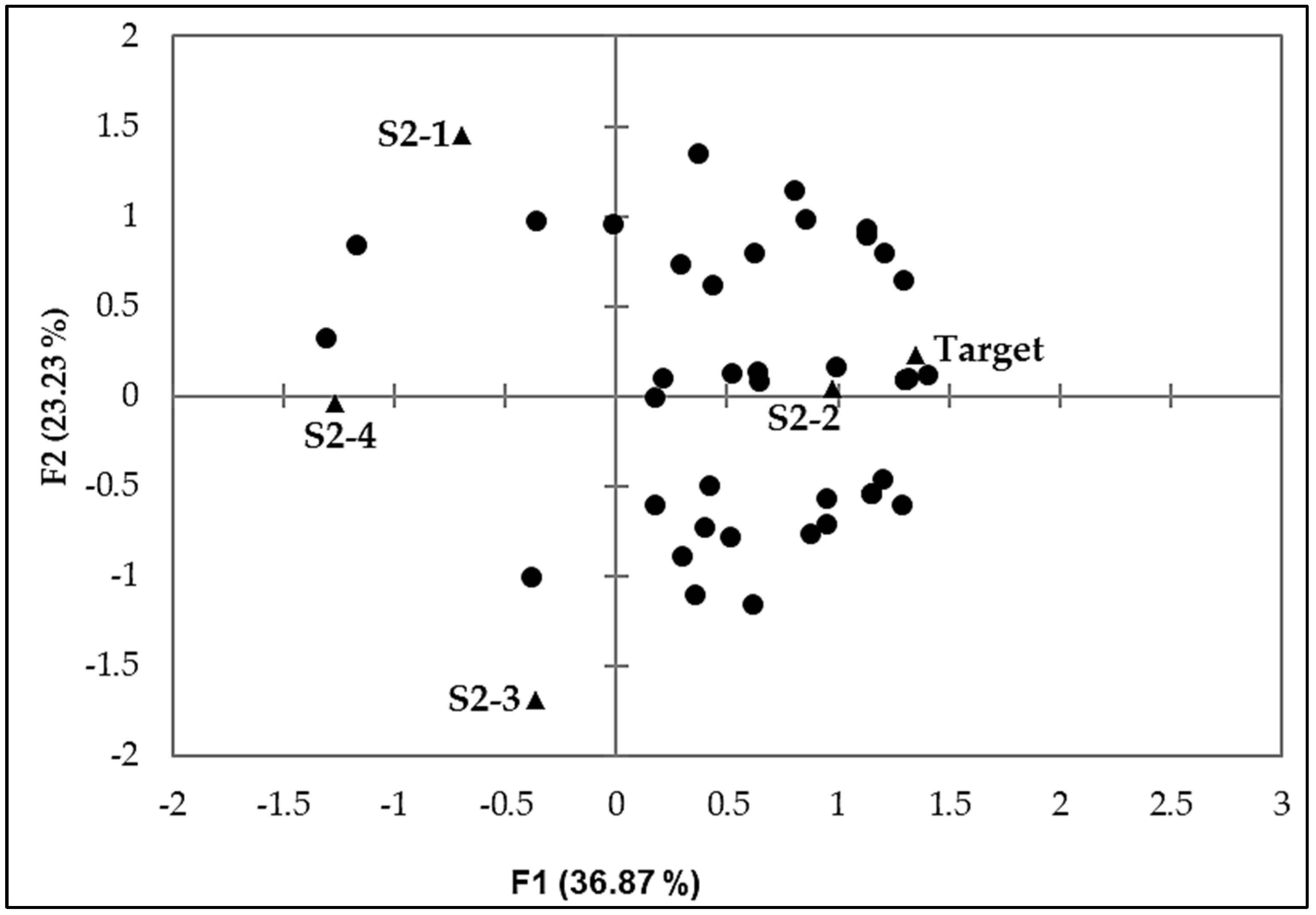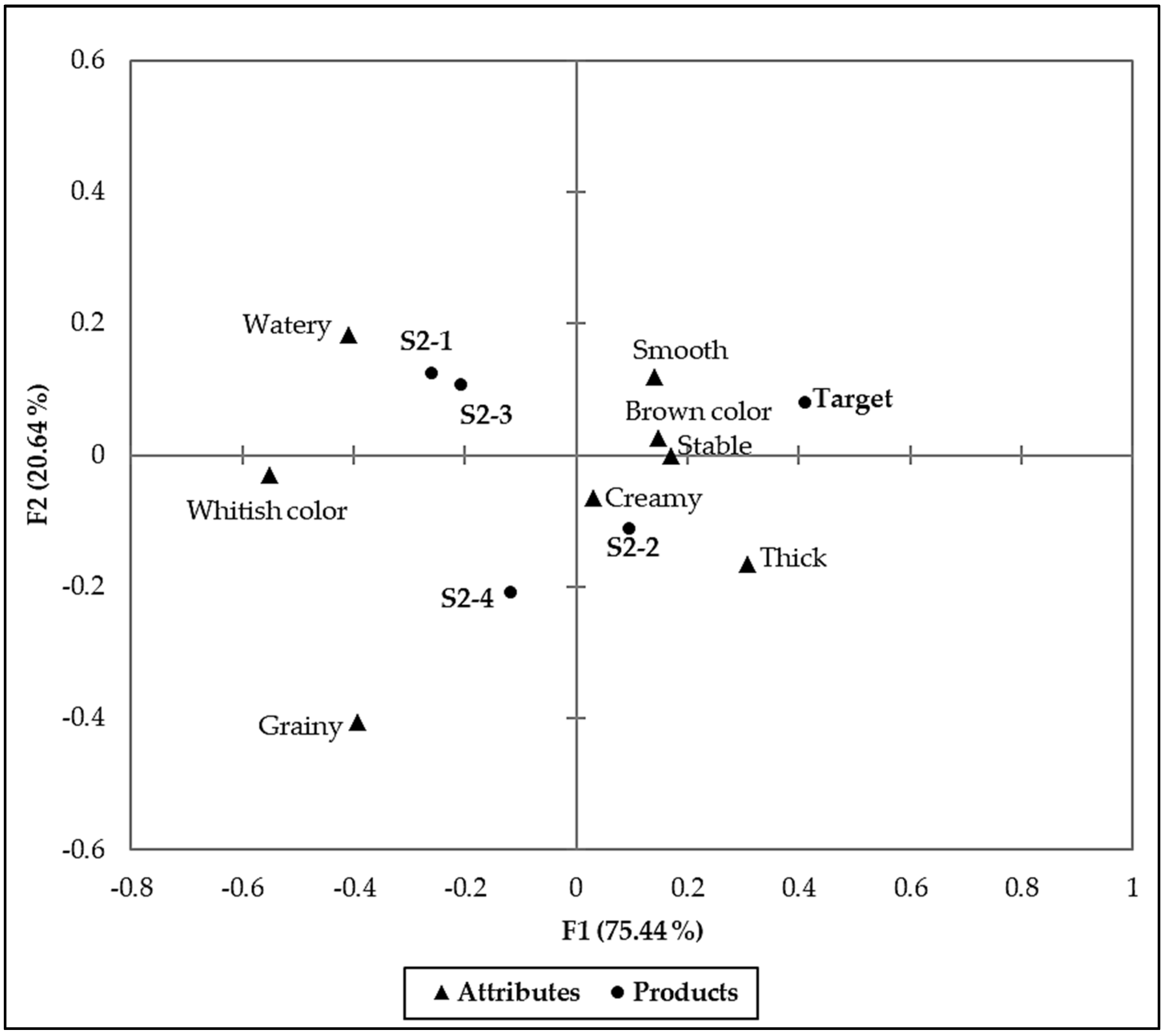Development and Optimization of Peanut-Based Beverages: A Malawian Consumer-Driven Approach
Abstract
:1. Introduction
2. Materials and Methods
2.1. Sample Preparation
2.2. Study Design
2.2.1. Step I: Product Optimization
2.2.2. Step II: Prediction Model Validation
2.2.3. Step III: Product Matching
2.3. Product Evaluations
2.4. Statistical Analysis
3. Results
3.1. Product Optimization and Validation
3.2. Product Matching
4. Discussion
5. Conclusions
Author Contributions
Funding
Institutional Review Board Statement
Informed Consent Statement
Data Availability Statement
Conflicts of Interest
References
- WHO. The Double Burden of Malnutrition. Available online: http://apps.who.int/iris/bitstream/10665/255413/1/WHO-NMH-NHD-17.3-eng.pdf?ua=1 (accessed on 14 July 2020).
- Eertmans, A.; Victoir, A.; Notelaers, G.; Vansant, G.; van den Bergh, O. The Food Choice Questionnaire: Factorial invariant over western urban populations? Food Qual. Prefer. 2006, 17, 344–352. [Google Scholar] [CrossRef]
- Gama, A.P.; Adhikari, K.; Hoisington, D.A. Factors influencing food choices of Malawian consumers: A food choice questionnaire approach. J. Sens. Stud. 2018, 33, e12442. [Google Scholar] [CrossRef]
- Jáuregui-Lobera, I.; Ríos, P.B. What motivates the consumer’s food choice? Nutr. Hosppitalaria 2011, 26, 1313–1321. [Google Scholar]
- Prescott, J.; Young, O.; O’neill, L.; Yau, N.; Stevens, R. Motives for food choice: A comparison of consumers from Japan, Taiwan, Malaysia and New Zealand. Food Qual. Prefer. 2002, 13, 489–495. [Google Scholar] [CrossRef]
- NPB. History of Peanuts and Peanut Butter. Available online: http://nationalpeanutboard.org/peanut-info/history-peanuts-peanut-butter.htm (accessed on 16 March 2020).
- Corbo, M.R.; Bevilacqua, A.; Petruzzi, L.; Casanova, F.P.; Sinigaglia, M. Functional beverages: The emerging side of functional foods: Commercial trends, research, and health implications. Compr. Rev. Food Sci. Food Saf. 2014, 13, 1192–1206. [Google Scholar] [CrossRef]
- Siro, I.; Kápolna, E.; Kápolna, B.; Lugasi, A. Functional food. Product development, marketing and consumer acceptance—A review. Appetite 2008, 51, 456–467. [Google Scholar] [CrossRef]
- Van Kleef, E.; van Trijp, H.C.; Luning, P. Consumer research in the early stages of new product development: A critical review of methods and techniques. Food Qual. Prefer. 2005, 16, 181–201. [Google Scholar] [CrossRef]
- Slater, S.F.; Narver, J.C. Intelligence generation and superior customer value. J. Acad. Mark. Sci. 2000, 28, 120–127. [Google Scholar] [CrossRef]
- Moskowitz, H.R. Product Testing and Sensory Evaluation of Foods: Marketing and R&D Approaches; Food & Nutrition Press, Inc.: Trumbull, CT, USA, 1983. [Google Scholar]
- Carpenter, R.P.; Lyon, D.H.; Hasdell, T.A. Guidelines for Sensory Analysis in Food Product Development and Quality Control; Springer Science & Business Media: New York, NY, USA, 2012. [Google Scholar]
- Meilgaard, M.C.; Carr, B.T.; Civille, G.V. Sensory Evaluation Techniques; CRC Press: Boca Raton, FL, USA, 2006. [Google Scholar]
- Ares, G. Methodological challenges in sensory characterization. Curr. Opin. Food Sci. 2015, 3, 1–5. [Google Scholar] [CrossRef]
- Varela, P.; Ares, G. Sensory profiling, the blurred line between sensory and consumer science. A review of novel methods for product characterization. Food Res. Int. 2012, 48, 893–908. [Google Scholar] [CrossRef]
- Jaeger, S.R.; Hunter, D.C.; Kam, K.; Beresford, M.K.; Jin, D.; Paisley, A.G.; Chheang, S.L.; Roigard, C.M.; Ares, G. The concurrent use of JAR and CATA questions in hedonic scaling is unlikely to cause hedonic bias, but may increase product discrimination. Food Qual. Prefer. 2015, 44, 70–74. [Google Scholar] [CrossRef]
- Rubico, S.; Phillips, R.; Resurreccion, A.; Beuchat, L. Nutritional, microbiological, and sensory qualities of a peanut beverage prepared using various processes. J. Food Sci. 1989, 54, 1540–1543. [Google Scholar] [CrossRef]
- Chompreeda, P.; Haruthaithanasan, V.; Oupadissakoon, C.; Suknak, K. Development of a chocolate flavored peanut beverage. J. Food Sci. 1989, 54, 1359–1360. [Google Scholar] [CrossRef]
- Galvez, F.C.F.; Resurreccion, A.V.; Koehler, P.E. Optimization of processing of peanut beverage. J. Sens. Stud. 1990, 5, 1–17. [Google Scholar] [CrossRef]
- Rustom, I.; López-Leiva, M.; Nair, B.M. UHT-Sterilized Peanut Beverages: Kinetics of Physicochemical Changes during Storage and Shelf-Life Prediction Modeling. J. Food Sci. 1996, 61, 198–203. [Google Scholar] [CrossRef]
- Hinds, M.J.; Beuchat, L.R.; Chinnan, M.S. Properties of a thermal-processed beverage prepared from roasted partially defatted peanuts. Int. J. Food Sci. Technol. 1997, 32, 203–211. [Google Scholar] [CrossRef] [Green Version]
- Deshpande, R.; Chinnan, M.; McWatters, K. Optimization of a chocolate-flavored, peanut–soy beverage using response surface methodology (RSM) as applied to consumer acceptability data. LWT-Food Sci. Technol. 2008, 41, 1485–1492. [Google Scholar] [CrossRef]
- Howard, B.M.; Hung, Y.C.; McWatters, S.K. Analysis of ingredient functionality and formulation optimization of an instant peanut beverage mix. J. Food Sci. 2010, 75, S8–S19. [Google Scholar] [CrossRef] [PubMed]
- Cornell, J.A. Experiments with Mixtures: Designs, Models, and the Analysis of Mixture Data; John Wiley & Sons: New York, NY, USA, 2011; Volume 403. [Google Scholar]
- Taylor, J. Overview: Importance of sorghum in Africa. In Proceedings of the Afripro: Workshop on the Proteins of Sorghum and Millets: Enhancing Nutritional and Functional Properties for Africa, Pretoria, South Africa, 2–4 April 2003. [Google Scholar]
- Clark, J.E. Taste and flavour: Their importance in food choice and acceptance. Proc. Nutr. Soc. 1998, 57, 639–643. [Google Scholar] [CrossRef] [Green Version]
- WHO. Promoting Fruit and Vegetable Consumption around the World. Available online: http://www.who.int/dietphysicalactivity/fruit/en/ (accessed on 19 November 2021).
- Fotopoulos, C.; Krystallis, A.; Vassallo, M.; Pagiaslis, A. Food Choice Questionnaire (FCQ) revisited. Suggestions for the development of an enhanced general food motivation model. Appetite 2009, 52, 199–208. [Google Scholar] [CrossRef]
- Januszewska, R.; Pieniak, Z.; Verbeke, W. Food choice questionnaire revisited in four countries. Does it still measure the same? Appetite 2011, 57, 94–98. [Google Scholar] [CrossRef] [PubMed]
- Gama, A.P.; Hung, Y.-C.; Adhikari, K. Optimization of emulsifier and stabilizer concentrations in a model Peanut-Based beverage system: A mixture design approach. Foods 2019, 8, 116. [Google Scholar] [CrossRef] [PubMed] [Green Version]



| Source | Sum of Squares | df | Mean Square | F-Value | p-Value |
|---|---|---|---|---|---|
| Mean vs. Total | 222.68 | 1 | 222.68 | - | - |
| Linear vs. Mean | 0.0276 | 1 | 0.0276 | 0.0245 | 0.8855 |
| Quadratic vs. Linear | 3.29 | 1 | 3.29 | 85.80 | 0.0115 * |
| Cubic vs. Quadratic | 0.0017 | 1 | 0.0017 | 0.0225 | 0.9052 |
| Quartic vs. Cubic | 0.0750 | 1 | 0.0750 | - | - |
| Residual | 0.0000 | 0 | - | - | |
| Total | 226.08 | 5 | 45.22 | - | - |
| Mixture Composition | Overall Liking Score | Relative Error (%) | ||||
|---|---|---|---|---|---|---|
| Product | PP | BMMP | Predicted | Actual 1 | CV (%) | |
| Optimal | 0.60 | 0.40 | 7.59 | 7.53 | 0.56 | 0.80 |
| S1-1 | 0.15 | 0.85 | 6.62 | 6.45 | 1.29 | 1.85 |
| S1-2 | 0.70 | 0.30 | 7.38 | 7.28 | 0.96 | 1.37 |
| Mixture Composition | Mean ± SD | ||||||||
|---|---|---|---|---|---|---|---|---|---|
| Product | PP | BMMP | SMMP-1 | SMMP-2 | Appearance | Aroma | Flavor | Texture | Overall Liking |
| S2-1 | 0.6 | 0.0 | 0.0 | 0.4 | 6.4 ± 1.4 b | 6.4 ± 1.1 b | 6.4 ± 1.4 a | 6.6 ± 1.8 b | 6.5 ± 1.4 b |
| S2-2 | 0.6 | 0.0 | 0.4 | 0.0 | 6.7 ± 1.1 b | 7.5 ± 1.1 a | 7.3 ± 1.3 a | 6.7 ± 1.3 a,b | 7.7 ± 1.0 a |
| S2-3 | 0.5 | 0.0 | 0.5 | 0.0 | 6.3 ± 1.5 b | 6.3 ± 1.2 b | 6.7 ± 1.5 a | 6.6 ± 1.5 b | 6.6 ± 1.5 b |
| S2-4 | 0.5 | 0.0 | 0.0 | 0.5 | 6.1 ± 1.7 b | 6.4 ± 1.2 b | 6.9 ± 1.6 a | 6.5 ± 1.7 b | 6.7 ± 1.5 b |
| Target | 0.6 | 0.4 | 0.0 | 0.0 | 8.0 ± 0.9 a | 7.3 ± 1.0 a | 6.9 ± 1.1 a | 7.6 ± 1.1 a | 7.5 ± 0.8 a |
| Citation Frequency (%) | ||||||
|---|---|---|---|---|---|---|
| Descriptor | p-Value | S2-1 | S2-2 | S2-3 | S2-4 | Target |
| Tasty | 0.490 | 50.0 a | 52.6 a | 63.2 a | 60.5 a | 60.5 a |
| Tasteless | 0.483 | 5.3 a | 2.6 a | 7.9 a | 0.0 a | 5.3 a |
| Sweet | 0.690 | 73.7 a | 76.3 a | 84.2 a | 76.3 a | 73.7 a |
| Bitter | 0.406 | 13.2 a | 5.3 a | 10.5 a | 5.3 a | 5.3 a |
| Salty | 0.105 | 13.2 a | 15.8 a | 10.5 a | 23.7 a | 5.3 a |
| Sour | 0.255 | 0.0 a | 5.3 a | 0.0 a | 2.6 a | 0.0 a |
| Aromatic | 0.092 | 39.5 a | 43.2 a | 47.4 a | 39.5 a | 55.3 a |
| Roasted peanut flavor | 0.377 | 65.8 a | 63.2 a | 71.1 a | 57.9 a | 73.7 a |
| Smooth | 0.000 | 50.0 b | 57.9 a,b | 57.9 a,b | 39.5 b | 84.2 a |
| Grainy | 0.001 | 18.4 a,b | 23.7 a,b | 21.1 a,b | 36.8 a | 2.6 b |
| Creamy | 0.046 | 55.3 b | 68.4 a | 63.2 a | 73.7 a | 78.9 a |
| Stable | 0.000 | 44.7 b | 44.7 b | 36.8 b | 52.6 a,b | 78.9 a |
| Brown color | 0.000 | 50.0 b | 68.4 ab | 57.9 b | 52.6 b | 89.5 a |
| Whitish color | 0.000 | 42.1 a | 23.7 a,b | 39.5 a | 36.8 a | 2.6 b |
| Thick | 0.000 | 18.4 b | 44.7 a,b | 21.1 b | 39.5 a,b | 57.9 a |
| Watery | 0.000 | 60.5 a | 26.3 b,c | 57.9 a,b | 36.8 a,b,c | 21.1 c |
Publisher’s Note: MDPI stays neutral with regard to jurisdictional claims in published maps and institutional affiliations. |
© 2022 by the authors. Licensee MDPI, Basel, Switzerland. This article is an open access article distributed under the terms and conditions of the Creative Commons Attribution (CC BY) license (https://creativecommons.org/licenses/by/4.0/).
Share and Cite
Gama, A.P.; Adhikari, K. Development and Optimization of Peanut-Based Beverages: A Malawian Consumer-Driven Approach. Foods 2022, 11, 267. https://doi.org/10.3390/foods11030267
Gama AP, Adhikari K. Development and Optimization of Peanut-Based Beverages: A Malawian Consumer-Driven Approach. Foods. 2022; 11(3):267. https://doi.org/10.3390/foods11030267
Chicago/Turabian StyleGama, Aggrey Pemba, and Koushik Adhikari. 2022. "Development and Optimization of Peanut-Based Beverages: A Malawian Consumer-Driven Approach" Foods 11, no. 3: 267. https://doi.org/10.3390/foods11030267
APA StyleGama, A. P., & Adhikari, K. (2022). Development and Optimization of Peanut-Based Beverages: A Malawian Consumer-Driven Approach. Foods, 11(3), 267. https://doi.org/10.3390/foods11030267







